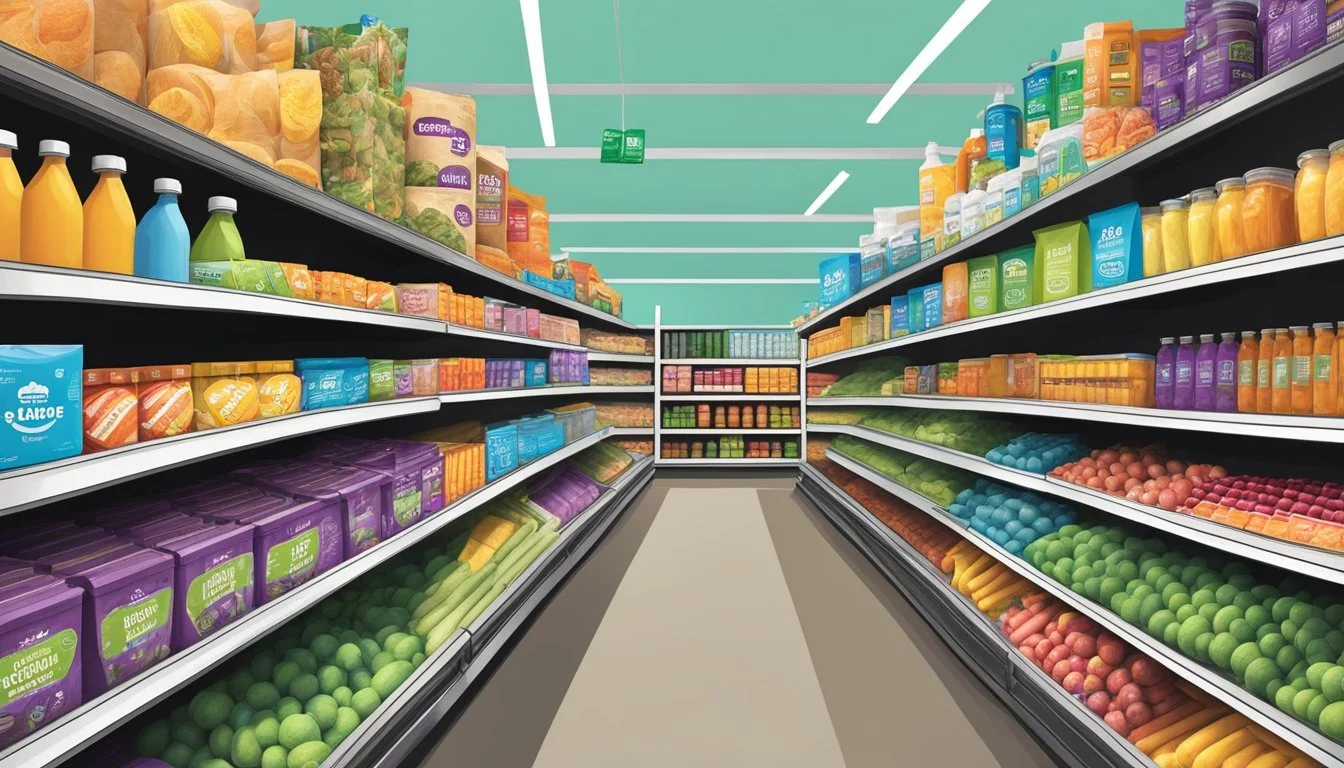Five Below vs Whole Foods
Comparing Budget and Premium Options
Five Below and Whole Foods cater to vastly different consumer needs and preferences in the retail landscape. While Five Below focuses on budget-friendly merchandise across various categories, Whole Foods specializes in high-quality natural and organic groceries.
Whole Foods generally offers superior quality and a wider selection of healthy, organic products, but at significantly higher prices compared to Five Below or traditional supermarkets. This price difference can amount to thousands of dollars annually for regular shoppers.
For those prioritizing natural and organic options, Whole Foods remains a top choice despite its premium pricing. However, budget-conscious consumers may find better value at Five Below for non-grocery items or at more affordable supermarkets like Walmart or Food Lion for everyday groceries.
History and Evolution of the Brands
Whole Foods Market and Five Below represent contrasting approaches to retail. Whole Foods revolutionized the grocery industry with its focus on organic products, while Five Below carved out a niche in low-cost retail aimed at younger shoppers.
Whole Foods Market: Pioneering the Organic Movement
Whole Foods Market began in 1980 when John Mackey and Renee Lawson Hardy opened a small natural foods store in Austin, Texas. The company quickly expanded, merging with other natural food retailers and opening new locations across the U.S.
By the 1990s, Whole Foods had become synonymous with organic and natural products. The chain played a crucial role in bringing organic foods into the mainstream, setting industry standards for quality and sustainability.
In 2017, Amazon acquired Whole Foods for $13.7 billion, marking a significant shift in the grocery landscape. This move allowed Whole Foods to leverage Amazon's technology and distribution network, further expanding its reach and influence.
Five Below: Redefining Low-Cost Retail
Five Below, founded in 2002 by David Schlessinger and Tom Vellios, took a different approach to retail. The chain focused on offering trendy products at low prices, specifically targeting teens and pre-teens.
Starting with a single store in Wayne, Pennsylvania, Five Below rapidly expanded across the United States. The company's unique concept of selling items for $5 or less resonated with young consumers and budget-conscious shoppers.
Five Below went public in 2012, fueling further growth. The chain has continued to evolve, introducing new product categories and experimenting with higher price points in some stores while maintaining its core $5-and-below concept.
Business Models and Growth Strategies
Whole Foods and Five Below employ distinct strategies to attract customers and drive growth. Their approaches to pricing, product selection, and target markets shape their business models and expansion plans.
Whole Foods: Premium Pricing for Quality
Whole Foods focuses on high-quality, organic, and natural products with premium pricing. The company targets health-conscious consumers willing to pay more for fresh, sustainably sourced foods. Whole Foods' acquisition by Amazon in 2017 led to integration with Amazon Prime, offering exclusive discounts to Prime members.
The retailer's growth strategy involves expanding its physical store presence and enhancing its online capabilities. Whole Foods has over 500 locations in the U.S. and continues to open new stores in strategic areas. The company also leverages Amazon's e-commerce expertise to improve its delivery and pickup services.
Whole Foods differentiates itself through its curated product selection, in-store experiences, and commitment to quality standards. This approach appeals to a niche market segment and supports higher profit margins.
Five Below: Keeping Costs Low
Five Below operates on a discount retail model, offering products priced at $5 or less. The company targets value-conscious shoppers, particularly teens and pre-teens, with a diverse range of trendy merchandise. Five Below's strategy focuses on rapid expansion and maintaining low operating costs.
The retailer's growth plan includes aggressive store openings across the United States. Five Below aims to reach 2,500+ locations in the long term, capitalizing on its broad appeal and affordable pricing. The company's store layout and product mix are designed to encourage impulse purchases and frequent visits.
Five Below's business model relies on high sales volume and efficient operations to offset its low prices. The company sources products directly from manufacturers and maintains a lean inventory management system to keep costs down. This approach allows Five Below to offer competitive prices while still generating profits.
Product Range and Quality
Whole Foods and Five Below offer distinctly different product ranges and quality standards. Whole Foods focuses on natural and organic offerings, while Five Below provides a diverse array of affordable items.
Whole Foods: A Commitment to Natural and Organic
Whole Foods prioritizes high-quality, organic produce and meats. Their fruits and vegetables are sourced from local and sustainable farms. The store's meat department features antibiotic-free and hormone-free options. Organic products make up a significant portion of their inventory.
Whole Foods maintains strict quality standards for all items sold in their stores. They ban artificial preservatives, colors, flavors, and sweeteners. The company also emphasizes transparency in labeling and ingredient sourcing.
Their commitment to quality extends beyond food. Whole Foods offers natural beauty products, supplements, and household items that meet their rigorous standards.
Five Below: Diversity in Affordable Products
Five Below takes a different approach, focusing on affordability and variety. Their grocery section, while limited, includes a mix of brand-name and generic products. The store offers snacks, beverages, and some packaged foods.
Five Below's strength lies in its diverse non-food offerings. Customers can find kitchen gadgets, party supplies, and seasonal items at low prices. The quality of these products varies, with some items being more durable than others.
Unlike Whole Foods, Five Below does not specialize in organic or natural products. Their focus is on providing a wide range of items at $5 or less, catering to budget-conscious shoppers looking for everyday essentials and fun novelties.
Pricing Strategies
Five Below and Whole Foods employ vastly different pricing strategies to attract their target customers. These approaches reflect each retailer's unique market positioning and value proposition.
Price Comparison: Balancing Cost and Value
Five Below focuses on extreme affordability, with most items priced at $5 or less. This strategy appeals to budget-conscious shoppers and impulse buyers. The company leverages bulk purchasing and efficient supply chain management to maintain low prices.
Whole Foods, in contrast, positions itself as a premium grocer. Its prices are generally higher than traditional supermarkets, reflecting the cost of organic and sustainably sourced products. The acquisition by Amazon has led to some price reductions, particularly for Amazon Prime members.
Both retailers offer store brands to provide value. Five Below's private label items maintain the $5-or-less price point. Whole Foods' 365 Everyday Value brand offers slightly lower prices on organic staples.
Understanding the Deals and Discounts
Five Below rarely offers traditional sales or coupons. Instead, the store occasionally introduces items priced below $5, creating a sense of added value for customers.
Whole Foods provides more varied discount options. Amazon Prime members receive exclusive deals and an additional 10% off sale items. The store also offers weekly specials and digital coupons through its app.
Seasonal promotions are common at both retailers. Five Below rotates themed merchandise, while Whole Foods features holiday-specific organic products at competitive prices.
Generic products play a significant role in both stores' pricing strategies. Five Below's low-cost generics allow for higher profit margins. Whole Foods uses its 365 brand to offer organic alternatives at more accessible price points.
Customer Experience
The customer experience at Whole Foods and Five Below differs significantly due to their distinct target markets and retail approaches. Each store employs unique strategies to cater to their customers' needs and preferences.
Service and Convenience at Whole Foods and Five Below
Whole Foods prioritizes personalized service and product knowledge. Staff members are often well-versed in organic and specialty foods, offering recommendations and answering questions. The store layout emphasizes fresh produce, prepared foods, and gourmet items, creating a premium shopping atmosphere.
Five Below, in contrast, focuses on a self-service model. The store design is simple and easy to navigate, with clearly marked sections for various product categories. Employees are available to assist, but the emphasis is on quick, efficient shopping for budget-conscious customers.
The Impact of Delivery and Checkout Innovations
Whole Foods has embraced technology to enhance convenience. They offer grocery delivery through Amazon Prime, allowing customers to shop online and receive orders at home. In-store, they've implemented mobile checkout options and self-service kiosks to reduce wait times.
Five Below has also adapted to changing consumer preferences. While not offering grocery delivery, they've streamlined their checkout process with efficient point-of-sale systems. Some locations have introduced self-checkout kiosks to speed up transactions during busy periods.
Both stores continue to innovate in response to customer demands for faster, more convenient shopping experiences.
Market Presence and Competition
Five Below and Whole Foods occupy vastly different positions in the retail landscape. Their market presence and competitive strategies reflect distinct approaches to serving consumers.
National Footprint and Competitor Comparison
Five Below operates over 1,300 stores across the United States, primarily in strip malls and shopping centers. Its main competitors include Dollar Tree, Dollar General, and other discount retailers. Whole Foods, in contrast, has around 500 locations, focusing on urban and affluent suburban areas. Whole Foods faces competition from traditional supermarkets like Kroger and Wegmans, as well as specialty grocers like Trader Joe's and Sprouts Farmers Market.
Walmart remains the dominant force in grocery retail, with over 4,700 U.S. stores. Kroger operates nearly 2,800 locations under various banners. Aldi has rapidly expanded to over 2,000 stores, while Publix maintains a strong regional presence with 1,300 stores in the Southeast.
Grocery Store Rivalry and Consumer Choice
Whole Foods competes primarily on quality and selection of natural and organic products. Its acquisition by Amazon in 2017 has bolstered its online presence and delivery capabilities. Traditional supermarkets have expanded their organic offerings to compete with Whole Foods.
Five Below, not typically considered a grocery competitor, has introduced limited food sections in some stores. This move puts it in indirect competition with dollar stores and discount chains that offer packaged foods and snacks.
Consumer choice in the grocery sector continues to expand. Shoppers can now select from traditional supermarkets, specialty grocers, discount chains, and online options. This diversity allows consumers to prioritize factors like price, quality, convenience, and product selection when choosing where to shop.
Consumer Loyalty and Feedback
Five Below and Whole Foods have distinct approaches to building customer loyalty and gathering feedback. These strategies significantly impact their success and reputation in the grocery market.
Brand Loyalty and Return Customers
Five Below focuses on attracting budget-conscious shoppers with its low-price model. The store's loyal following primarily consists of teens and young adults seeking affordable trendy items. Its frequent product rotations encourage repeat visits.
Whole Foods, on the other hand, cultivates a dedicated customer base interested in organic and natural products. The store's emphasis on quality and ethical sourcing resonates with health-conscious consumers. Whole Foods' loyalty program, integrated with Amazon Prime, offers exclusive discounts to incentivize return visits.
Both stores face competition from traditional supermarkets like Harris Teeter and Safeway, which have their own established customer bases.
Feedback Mechanisms and Consumer Ratings
Five Below employs social media and in-store surveys to gather customer feedback. The company actively engages with its younger demographic through platforms like Instagram and TikTok.
Whole Foods utilizes multiple channels for customer feedback, including in-store comment cards, online surveys, and social media. The store's reputation for customer service contributes to generally positive ratings.
Both chains monitor consumer ratings on various platforms to identify areas for improvement. Independent surveys have shown that Whole Foods typically scores higher in customer satisfaction compared to Five Below, particularly in product quality and store atmosphere.
Sustainability and Ethical Considerations
Five Below and Whole Foods take different approaches to sustainability and ethical practices. Their policies impact the environment and local communities in distinct ways.
Environmental Impact of Grocery Shopping
Whole Foods prioritizes sustainability throughout its operations. The company uses 100% post-consumer recycled-content paper bags and implements composting programs in many stores. They've installed low-flow toilets and rainwater collection systems to reduce water usage.
Five Below's environmental initiatives are less prominent. The discount retailer focuses more on low prices than eco-friendly practices. However, they have made efforts to reduce packaging waste in recent years.
Both stores offer reusable shopping bags, but Whole Foods actively encourages their use. Whole Foods also provides extensive recycling options for customers in many locations.
Ethical Sourcing and Community Impact
Whole Foods is known for its commitment to ethical sourcing. They offer a wide selection of organic produce and natural products. The company has strict animal welfare standards for meat and seafood.
Five Below's sourcing practices are less transparent. As a discount retailer, they prioritize low costs over ethical considerations in many cases.
Whole Foods supports local farmers and producers through its Local Producer Loan Program. They also donate to community organizations and food banks regularly.
Five Below engages in charitable giving, but on a smaller scale. Their community impact focuses more on providing affordable products to customers.
Conclusion
Five Below and Whole Foods cater to vastly different market segments. Five Below focuses on affordable, trendy items for young consumers. Whole Foods emphasizes high-quality, organic products for health-conscious shoppers.
The choice between these stores depends on individual priorities and budgets. Five Below offers unbeatable prices on a variety of non-grocery items. Whole Foods provides premium groceries and prepared foods.
For everyday essentials and fun finds, Five Below is hard to beat. Shoppers seeking organic produce and specialty ingredients will prefer Whole Foods. Many consumers may find value in shopping at both stores for different needs.
Store atmosphere also differs significantly. Five Below creates a lively, colorful environment. Whole Foods offers a more upscale, sophisticated shopping experience.
Ultimately, both retailers excel in their respective niches. Five Below delivers on affordability and variety. Whole Foods maintains its reputation for quality and health-focused options.










